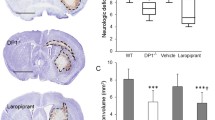Abstract
The surgical brain injury model replicates neurosurgical brain parenchymal damage. Postsurgical brain edema correlates with postoperative neurological dysfunction. Intranasal administration is a proven method of delivering therapies to brain tissue. Thrombin preconditioning decreased brain edema and improved neurological outcomes in models of ischemic brain injury. We hypothesized thrombin preconditioning in surgical brain injury may improve postoperative brain edema and neurological outcomes. Adult male Sprague-Dawley rats (n = 78) weighing 285–355 g were randomly assigned to sham or pre-injury treatment: one-time pretreatment 1 day prior, one-time pretreatment 5 days prior, and daily preconditioning for 5 days prior. Treatment arms were divided into vehicle or thrombin therapies, and subdivided into intranasal (thrombin 5 units/50 μL 0.9 % saline) or intracerebral ventricular (thrombin 0.1 unit/10 μL 0.9 % saline) administration. Blinded observers performed neurological testing 24 h after brain injury followed immediately by measurement of brain water content. There was a significant difference in ipsilateral brain water content and neurological outcomes between all treatment groups and the sham group. However, there was no change in brain water content or neurological outcomes between thrombin- and vehicle-treated animals. Thrombin preconditioning did not significantly improve brain edema or neurological function in surgical brain injury in rats.
Access this chapter
Tax calculation will be finalised at checkout
Purchases are for personal use only
Similar content being viewed by others
References
Benggon M, Chen H, Applegate R, Martin R, Zhang JH (2012) Effect of dexmedetomidine on brain edema and neurological outcomes in surgical brain injury in rats. Anesth Analg 115:154–159
De Rosa R, Garcia AA, Braschi C, Capsoni S, Maffei L, Berardi N, Cattaneo A (2005) Intranasal administration of nerve growth factor (NGF) rescues recognition memory deficits in AD11 anti-NGF transgenic mice. Proc Natl Acad Sci U S A 102:3811–3816
Garcia JH, Wagner S, Liu KF, Hu XJ (1995) Neurological deficit and extent of neuronal necrosis attributable to middle cerebral artery occlusion in rats. Statistical validation. Stroke 26:627–634
Granziera C, Thevenet J, Price M, Wiegler K, Magistretti PJ, Badaut J, Hirt L (2007) Thrombin-induced ischemic tolerance is prevented by inhibiting c-jun N-terminal kinase. Brain Res 1148:217–225
Henrich-Noack P, Striggow F, Reiser G, Reymann KG (2006) Preconditioning with thrombin can be protective or worsen damage after endothelin-1-induced focal ischemia in rats. J Neurosci Res 83:469–475
Hirt L, Ternon B, Price M, Mastour N, Brunet JF, Badaut J (2009) Protective role of early aquaporin 4 induction against postischemic edema formation. J Cereb Blood Flow Metab 29:423–433
Illum L (2000) Transport of drugs from the nasal cavity to the central nervous system. Eur J Pharm Sci 11:1–18
Jadhav V, Matchett G, Hsu FP, Zhang JH (2007) Inhibition of Src tyrosine kinase and effect on outcomes in a new in vivo model of surgically induced brain injury. J Neurosurg 106:680–686
Kato H, Liu Y, Araki T, Kogure K (1991) Temporal profile of the effects of pretreatment with brief cerebral ischemia on the neuronal damage following secondary ischemic insult in the gerbil: cumulative damage and protective effects. Brain Res 553:238–242
Masada T, Xi G, Hua Y, Keep RF (2000) The effects of thrombin preconditioning on focal cerebral ischemia in rats. Brain Res 867:173–179
Matchett G, Hahn J, Obenaus A, Zhang J (2006) Surgically induced brain injury in rats: the effect of erythropoietin. J Neurosci Methods 158:234–241
Pantoni L, Bartolini L, Pracucci G, Inzitari D (1998) Interrater agreement on a simple neurological score in rats. Stroke 29:871–872
Papadopoulos MC, Manley GT, Krishna S, Verkman AS (2004) Aquaporin-4 facilitates reabsorption of excess fluid in vasogenic brain edema. FASEB J 18:1291–1293
Price M, Badaut J, Thevenet J, Hirt L (2010) Activation of c-Jun in the nuclei of neurons of the CA-1 in thrombin preconditioning occurs via PAR-1. J Neurosci Res 88:1338–1347
Schallert T, Fleming SM, Leasure JL, Tillerson JL, Bland ST (2000) CNS plasticity and assessment of forelimb sensorimotor outcome in unilateral rat models of stroke, cortical ablation, parkinsonism and spinal cord injury. Neuropharmacology 39:777–787
Thorne RG, Frey WH 2nd (2001) Delivery of neurotrophic factors to the central nervous system: pharmacokinetic considerations. Clin Pharmacokinet 40:907–946
Xi G, Keep RF, Hua Y, Xiang J, Hoff JT (1999) Attenuation of thrombin-induced brain edema by cerebral thrombin preconditioning. Stroke 30:1247–1255
Disclosure
This study was supported in part by National Institutes of Health grant NS084921. All authors attest they have no conflicts of interest to disclose.
Author information
Authors and Affiliations
Corresponding author
Editor information
Editors and Affiliations
Rights and permissions
Copyright information
© 2016 Springer International Publishing Switzerland
About this chapter
Cite this chapter
Benggon, M., Chen, H., Applegate, R.L., Zhang, J. (2016). Thrombin Preconditioning in Surgical Brain Injury in Rats. In: Applegate, R., Chen, G., Feng, H., Zhang, J. (eds) Brain Edema XVI. Acta Neurochirurgica Supplement, vol 121. Springer, Cham. https://doi.org/10.1007/978-3-319-18497-5_52
Download citation
DOI: https://doi.org/10.1007/978-3-319-18497-5_52
Publisher Name: Springer, Cham
Print ISBN: 978-3-319-18496-8
Online ISBN: 978-3-319-18497-5
eBook Packages: MedicineMedicine (R0)



